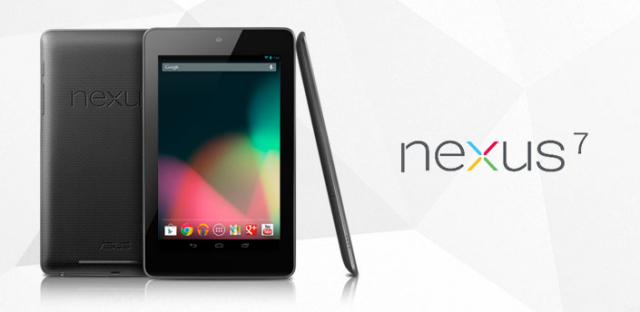
Google’s first branded tablet, the Nexus 7, has made its official debut, following months of speculation and leaks.
[aditude-amp id="flyingcarpet" targeting='{"env":"staging","page_type":"article","post_id":480644,"post_type":"story","post_chan":"none","tags":null,"ai":false,"category":"none","all_categories":"mobile,","session":"B"}']Today, Google director of Android product management Hugo Barra unveiled the Nexus 7 to a packed crowd at the company’s annual Google I/O developer conference in San Francisco, Calif.
As anticipated, the Nexus 7 is a Google-branded version of Asus hardware running Jelly Bean software, the latest version of Google’s Android operating system. The slate features a 7-inch IPS display with 1,280 x 800 resolution, a 1.3-GHz Nvidia Tegra 3 processor, 1GB of RAM, a 1.2-megapixel front-facing camera, and nine hours of video playback.
AI Weekly
The must-read newsletter for AI and Big Data industry written by Khari Johnson, Kyle Wiggers, and Seth Colaner.
Included with VentureBeat Insider and VentureBeat VIP memberships.
The Nexus 7 retails for $199 (8 GB) and $249 (16 GB) and is available for pre-order today on the Google Play store. The device will begin shipping in mid July.
The tablet, as Barra and Google Play lead Chris Yerga stressed, was designed around Google Play and is intended to make applications work as beautifully possible. The device’s homescreen even features widgets, powered by a recommendations engine, that will make intelligent suggestions for apps, books, movies, and television shows that users may like.
Priced like a smartphone, sized like an e-reader, and packing the power of a full-featured slate, the Nexus 7 offers consumers a hybrid of the two most popular tablet styles on the market. As such, the device, should Google prove successful in bringing top applications over to its Google Play market, has the potential to make a splash in the tablet space and become the number two tablet, second only to the iPad, Altimeter Group mobile industry analyst Chris Silva told VentureBeat.
The tablet, said Silva, can beat Amazon’s competitively priced souped-up e-reader and go head-to-head with the iPad primarily because it will offer consumers an attractive, affordable tablet alternative that’s not just a device for media and content consumption but also a tool for productivity.
“The Nexus 7 resets the bar for a 7-inch tablet,” added Moor Insights & Strategy president and principal analyst Patrick Moorhead. “It is not a stripped down device like Amazon’s Kindle Fire, but full featured with a great Nvidia CPU and GPU, and HD display with full access to the Google Play store.”
The Nexus 7 is also Google‘s answer to the software fragmentation challenge that, in part, is keeping Android-powered tablets built, sold, and marketed by third-party hardware manufacturers from dominating the market.
[aditude-amp id="medium1" targeting='{"env":"staging","page_type":"article","post_id":480644,"post_type":"story","post_chan":"none","tags":null,"ai":false,"category":"none","all_categories":"mobile,","session":"B"}']
“Google needs a flagship device to drive penetration of Android,” said Silva. “It’s critical that Google makes some move in the hardware space … that people start to lust after.”
The Nexus 7 is that move.
[vb_gallery id=481027]
VentureBeat's mission is to be a digital town square for technical decision-makers to gain knowledge about transformative enterprise technology and transact. Learn More